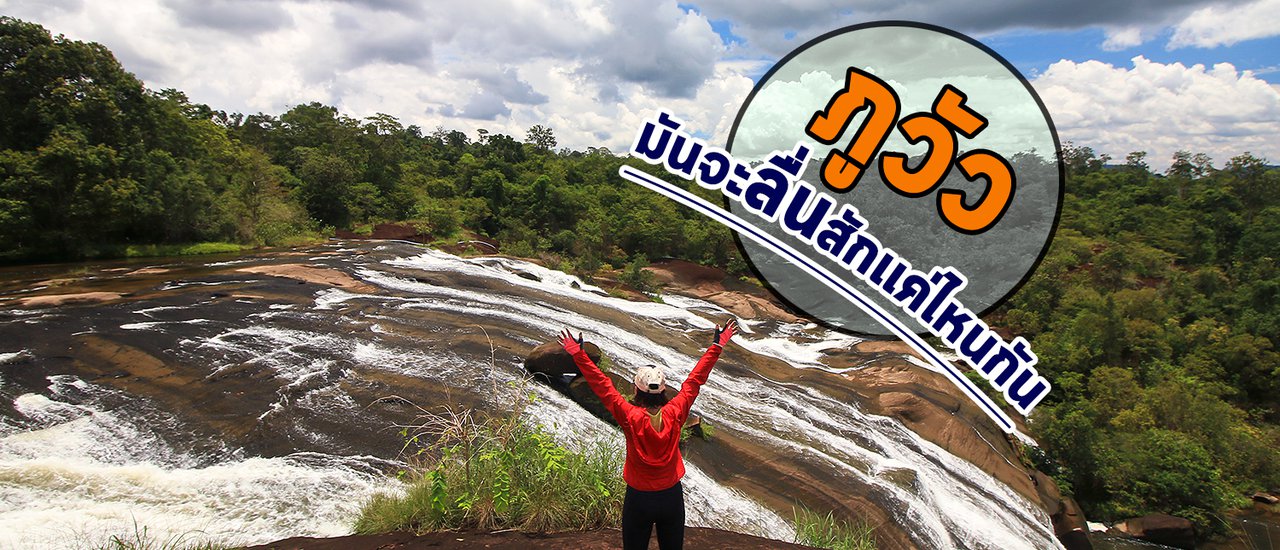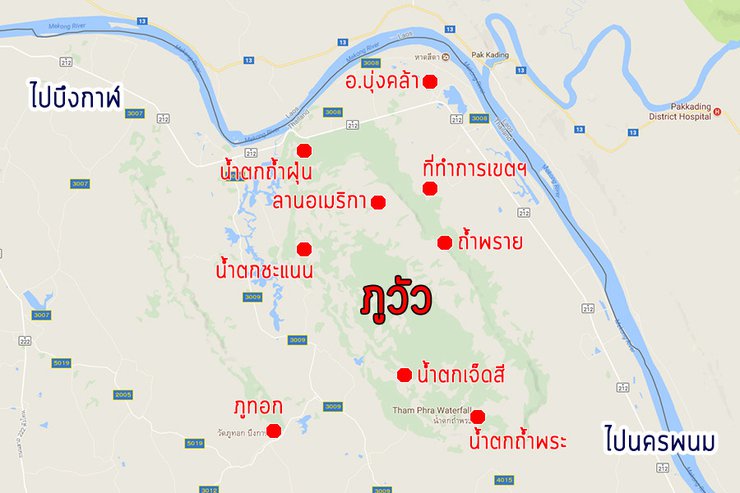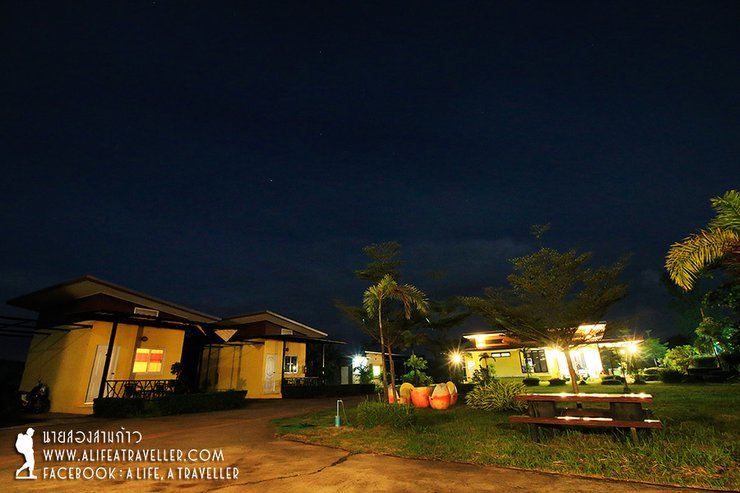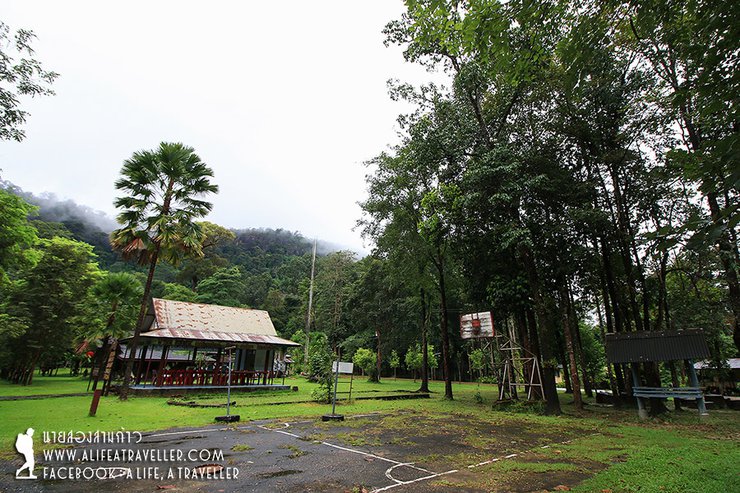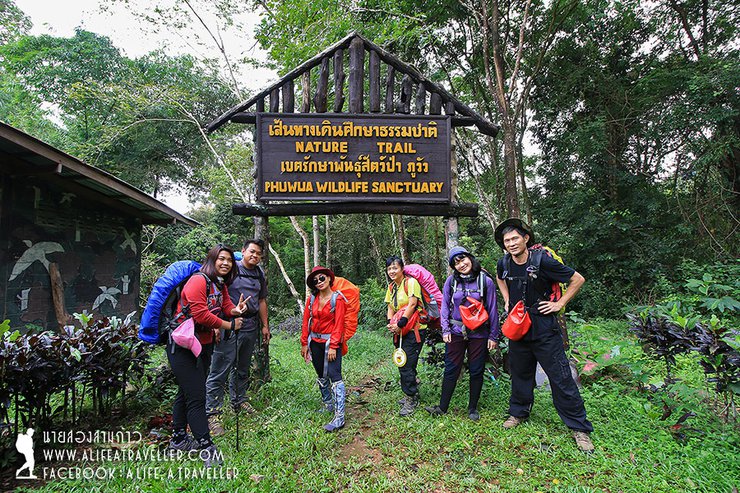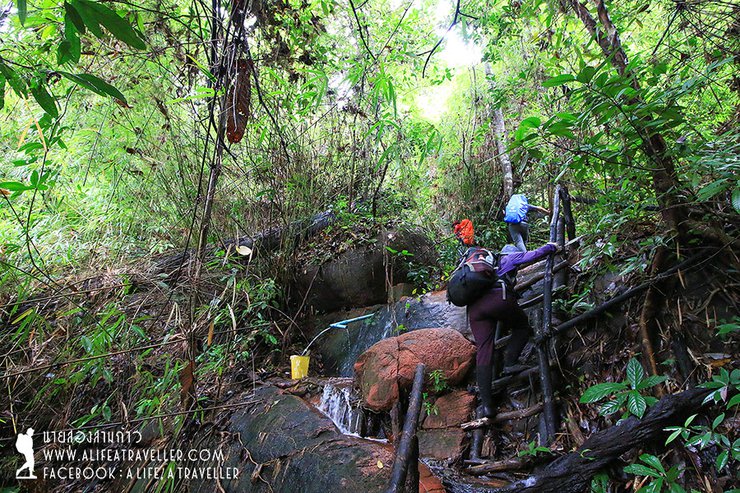The question is simple: where do you want to travel the most? My answer, without hesitation, is "Phu Wua and Cha Nan Waterfall." It's not far away, as it's located in Bueng Kan province. Sometimes our dreams are just around the corner, but why haven't we been there yet? So, I made a promise to myself this year that if I don't go, I'll stop traveling altogether. In early September, I finally made it happen.
The Wildlife Sanctuary of Phu Wua
The Phu Wua Wildlife Sanctuary, which I mentioned earlier, encompasses the districts of Bung Krar, Seka, and Bueng Khong Long. The sanctuary's headquarters are located in Bung Krar. Popular waterfalls for swimming, such as Tham Phra Waterfall and Chet Saai Waterfall, are also within the sanctuary's boundaries, although they are situated on the opposite side of the mountain from the headquarters.
The part I'm most excited about is a two-day, one-night nature study on Phu Wua. The route I know is to hike up to Lan Amerika to sleep, and the next day hike down to stay overnight at Cha Nan Waterfall.

As a wildlife sanctuary not open to the general public, overnight stays require a permit application to the Wildlife Conservation Office, located near Kasetsart University. Applications can be submitted in person or via email (see details > https://goo.gl/gyXQGo). Applications must be submitted at least 5 working days in advance, and a permit will be mailed to your address. The permit must be presented to the sanctuary upon arrival.
While it may appear complex, the process is actually quite straightforward. I submitted my application via email and it was completed quickly. The staff were very helpful and polite.
I'm reserving ten spots for this trip, and by the time we depart, I've managed to gather seven people, some of whom are meeting for the first time, as is typical when forming a group for such an outing. Once everyone is ready, we set off on our journey.
(1)
My friends took a bus from Bangkok. There were two bus companies: 407 Phatthana and Sawasdee Isan. Both companies go directly to Bung Krar District. Other companies only go to Bueng Kan Bus Terminal. From there, you need to take a van. I took a train from Korat to Nong Khai and then a van to Bung Krar. I stayed overnight in the district at The Khana Resort (Tel. 0811177606 0818723285). The rooms are new and clean, and it only costs 300 baht per night.

The morning of the meeting, it was drizzling non-stop. We gathered at Bung Krar District Office, bought fresh and dry food, and had breakfast. At around 8:30 AM, the officers' car picked us up and took us to the office. However, if anyone wants to pitch a tent or stay in the guesthouse inside, they can do so, but they need to contact in advance.


Upon arrival at the district office, we submitted our application letter and paid the entrance fee of 20 baht per person. The process was straightforward. Coincidentally, our group's visit coincided with the preparation for a retirement party, so we had to wait for the staff to clear some tasks. This was not a problem, as the waiting time was short.
11:20 AM is the starting time. The starting point is at the district office. The distance is only four kilometers. We will set up camp at the American Campsite.

The trail begins with a flat section of approximately 300 meters, followed by a moderately steep ascent up the mountain. While the climb is not particularly long, it's important to be cautious due to the slippery terrain. The path consists of sandstone covered in algae, aptly reflecting the local saying, "If you don't slip, you haven't truly experienced Mount Wua." The mountain's elevation ranges from 300 to 400 meters above sea level.



After about an hour, we reached the top of the mountain. From here, we had to be more careful. The damp, wet sandstone covered in moss was extremely slippery. If we weren't careful, we could easily slip and fall. Fortunately, it didn't rain, which would have made things even more difficult.

The sandstone forests may not be as lush as other types of forests, but they offer a unique and beautiful landscape. Despite the relatively low animal diversity, this area serves as a vital habitat for wild elephants in northeastern Thailand. Be warned, the elephants of Phu Wua are known for their aggressive behavior. For more information, search for "Phu Wua elephants" on Google.
We walked slowly, unable to take quick steps (haha…), crossing some streams. By one o'clock in the afternoon, we stopped to cook and eat instant noodles on a wide rock platform. We considered this point to be about halfway through our journey.



With a full stomach and renewed energy, we packed up and continued our journey. This is the kind of view I love.



During the rainy season, the mountains of Phu Wa are adorned with a vibrant array of wildflowers, including the striking Naak flowers. While the blooms may not cover as vast an area as those found on Phu Soi Dao, they still offer a delightful spectacle.




At two twenty in the afternoon, I crossed the stream here. I wanted to take a dip, but the officer told me to relax, there's a place to play near the campsite.


After walking for a while, I found evidence of its existence. Fortunately, judging from its condition, it seems to have passed several weeks, not recently.

And finally, shortly before three in the afternoon, we reached our destination, the American Campsite. This name comes from the fact that during World War II, American soldiers set up camp here.


The American field is characterized by a wide sandstone plain with scattered earthen mounds, providing opportunities for trees to grow. It looks like an island in the middle of the sea or an oasis in the desert. You can choose to tie a hammock or pitch a tent according to your preference.


No need to worry about water sources. The stream is located before the clearing, providing ample water for drinking and bathing (it is recommended to filter or boil the water before consumption). Of course, there are also excellent spots for swimming and bathing.


As dinner approached, everyone pitched in to help prepare the meal. If it was delicious, they ate a lot; if it wasn't, they still had to eat it. (Laughter…)


Shared joy among like-minded individuals.

After discussing the plan, we had to make a slight change. The park ranger informed us that the trail from Lan Amerika to Cha Nan Waterfall is currently impassable due to strong currents and the potential danger of wild elephants. As a result, we will spend the night at Tham Noi Waterfall tomorrow and then descend from the mountain the following day. We will then take a car to Cha Nan Waterfall, as it is accessible by pickup truck.
That night, the sky was overcast, with only clouds reflecting the orange and red moonlight. When the time was right, everyone went to sleep.

(2)
The new day arrived with a gentle drizzle. The officers woke up and asked if we had heard the faint sound of elephants the previous night. I was fast asleep and didn't hear anything, but one of the younger members of our group did. It's a good thing, because if we had heard it, there would have been chaos (laughter).
Today, we were in no rush due to the short walking distance, so we waited leisurely until the rain stopped. By the time we had eaten, packed up camp, and were ready to walk, it was already eleven o'clock. The sky began to clear, revealing patches of blue and occasional sunshine.


Our camp today is not far from yesterday's lunch spot. The distance from the American camp is about two kilometers, but even this short distance is difficult to cover quickly due to the slippery terrain. We keep slipping and sliding, dancing a breakdance all day long. The best way to avoid slipping is to take off your shoes and walk in socks. It's a surefire way to get a grip.




"Do you see the cliff face? That's where the officers will take us to enjoy the view today. It's called Phu Wua above Tham Phrai Cave."

Around 1 p.m., we passed the Mama Noodles Rock Field and arrived at the Tham Noi Waterfall stream, where we had lunch to recharge.




After that, walk empty-handed up to Phu Wua above Tham Phrai Cave. The round trip is two kilometers, with an elevation of 438 meters, making it the second highest peak on Phu Wua. The incline is not steep, but the slippery conditions remain the same.


The provided text is an empty paragraph containing only a line break. As there is no actual content to translate, I cannot provide a translation in this instance.
Please provide a sentence or phrase for me to translate.
Along the way, there were plenty of beautiful wildflowers, so we stopped to take some pictures.





Looking back from this point, you can see Phu Sam Yod. The long, far-right mountain is Phu Sing, where the famous Hin Sam Waan rocks are located. The next mountain to the left is also called Phu Sing. The lone peak on the far left is Phu Tok, where the Jetiyakhiri Wihan Temple is located, which many people may know.

We then reached the cliff face. From this side, we could see the Kham Pankan cliff, which looked like an interesting place to explore.

From this side, you can see the Bung Krar district stretching all the way to the Mekong River. The mountains you see are on the Lao side.



The local name for the cliff face above Tham Phrai Cave is "Phu Wua Nuea Tham Phrai." This translates to "Phu Wua Cliff above Tham Phrai Cave." In the Isan region, even a small overhang is considered a "Tham" (cave), unlike the larger cave structures we typically imagine. Tham Phrai is an example of such a formation.


On the way back from Tham Phrai, the officers really made us slip and fall all over the place. I myself lost everything for the first time here. So I can say with confidence that I finally made it to Phu Wua (laughs...).

After returning to the camp, we went down to play at the Tham Noi waterfall. The water is abundant and beautiful only during the rainy season. At night, we gathered around to eat and chat happily.


(3)
Notes:
- The original text is empty, so the translation is also empty.
- I am ready to translate sentences or phrases from Thai to English.
- Please provide the text you want me to translate.
- I will ensure the translation is of high quality and sounds natural, as if written by a native English speaker.
Following the schedule to visit Cha Nan Waterfall by car, we were in a hurry today. We skipped breakfast and started walking before 8:00 am. We arrived back at the office before 9:00 am. After a short wait, we were taken to Cha Nan Waterfall, Phu Tok, and dropped off at Bueng Kan Bus Terminal by an official's car. There was a reasonable charge for this service.

The route exits the protected area towards Seka district, or to put it simply, loops around the left side of Phu Wua. The entrance to Cha Nan Waterfall is on a fairly compact gravel road, but new road construction is currently underway. In the near future, it is expected to be a comfortable, long concrete road.

At 10:40 AM, we arrived at the Cha Nan Waterfall Forest Protection Unit. The first highlight is the stone bridge at the entrance of the waterfall, where the water flows under the stone platform.



The journey to Cha Nan Waterfall requires a 700-800 meter hike. Upon arrival, the waterfall's grandeur and beauty will leave you breathless, justifying the anticipation and desire to visit. The path allows for further exploration, and thick socks or multiple layers are recommended for better traction than shoes.



After climbing above the waterfall, we encountered a stream. Judging from the situation, the current wasn't too strong, so the officers guided us across. The water was refreshingly cool.

A breathtaking view of the waterfall from this side reveals its immense grandeur. Exercise caution, as the consequences of a misstep are self-evident.


Continue walking a little further and you will reach the Crocodile Palace, which is part of the Chanan Waterfall.

After spending some time playing in the water at Cha Nan Waterfall, it was time to say goodbye and move on. My friends wanted to climb Phu Tok, but I decided to wait below. I plan to come back for a longer trip next time, so this time I was content with just hiking Phu Wua and experiencing Cha Nan Waterfall.

Based on discussions with park rangers and porters, there are many more beautiful natural trails on Phu Wa Mountain. The specific trails you choose will depend on the season, conditions, and accessibility at the time. This means that if you return, you can explore different trails.
This is exactly what I wanted. If the first time made me fall in love, then love must surely bring me back again and again.
Contact Phu Wua Wildlife Sanctuary at 0853307211.
Tourism Expenses
- Entrance fee: 20 baht per person
- Guide: 500 baht per day (500x3)
- Porter: 500 baht per day (500x3)
- Pickup truck: Wildlife Sanctuary - Cha Nan Waterfall - Phu Tok - Bung Kan Bus Terminal 2,000 baht
Follow my travel adventures on another channel.
http://www.facebook.com/alifeatraveller
นายสองสามก้าว / A Life, A Traveller
Wednesday, October 9, 2024 6:02 PM

